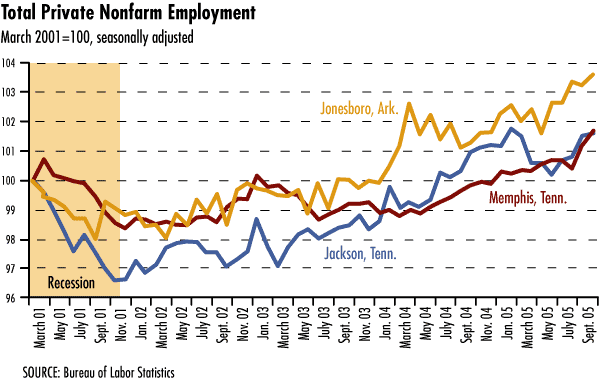District Overview: Employment Trends in Nearby Metro Areas Take Different Paths
The Memphis Zone of the Eighth Federal Reserve District has two metropolitan statistical areas besides Memphis.1 They are Jonesboro, Ark., and Jackson, Tenn. Although they are within three hours’ driving time of each other, these two metro areas are rather far apart in their recent employment history. Jobs in Jackson fell more sharply than they did in Jonesboro during the 2001 recession. Jackson has been slower to recover, too.
Jonesboro and Jackson share some job history: During the recession, both experienced large employment declines in manufacturing and in professional and business services, and in recent years both metro areas have seen remarkable resilience in the education and health services sector and in the leisure and hospitality sector.
Jackson’s downturn in total nonfarm employment started a year prior to the national recession. Between March 2000 and March 2001, when the U.S. recession began, Jackson lost about 1,700 jobs, a decline of 2.8 percent. During the recession itself, Jackson lost an additional 2,070 jobs, or 3.5 percent.2 Employment in Jackson began to recover in November 2001, the same month that the U.S. recession ended. From then until October 2005, Jackson’s employment increased by roughly 3,040 jobs, a net gain of about 970 jobs over the March 2001 level and about 80 percent of the jobs lost between March 2000 and November 2001.

As in Jonesboro, Memphis, and the country as a whole, the sectors that were most deeply affected in Jackson during the recession were manufacturing and the professional and business services sector. Between March and November 2001, employment in professional and business services declined by about 900 jobs, or 19 percent. From November 2001 to October 2005, this sector managed to recover only about 55 percent of those jobs. Manufacturing employment in Jackson experienced a boom during the 1990s, but it has declined steadily since early 2000. Manufacturing lost about 700 jobs during the recession, roughly 5.5 percent; the sector then lost 1,050 additional jobs between November 2001 and October 2005.
In contrast, two sectors saw increases in employment during the recession in Jackson: the education and health services sector and the leisure and hospitality sector. From March 2001 to October 2005, each of these sectors had grown by approximately 13 percent.
In Jonesboro, total nonfarm employment during the recession fell by about 460 jobs, roughly 1 percent. As can be seen in the chart, Jonesboro’s employment performance relative to its March 2001 level exceeded that of Jackson and Memphis. Nonfarm employment in Jonesboro returned to its March 2001 level by February 2004, six months ahead of Jackson and the state of Arkansas and about 12 months ahead of Memphis. Jonesboro’s employment continued to grow; from November 2001 to October 2005, about 2,180 new jobs had been created.
Manufacturing employment in Jonesboro during the recession declined by about 1,050 jobs, or 10 percent, and it continued to drop after the end of the recession, losing another 580 jobs between November 2001 and October 2005.
Professional and business services jobs fell by 6.4 percent during the recession, a loss of about 200 jobs, but unlike manufacturing, this sector recovered quite well. From November 2001 to October 2005, the professional and business services sector gained approximately 450 jobs, more than double the amount of jobs lost during the recession. Jonesboro’s performance in this sector contrasts sharply with the performance of both Memphis and Jackson, where the number of jobs had not yet reached the March 2001 level by October 2005.
Jonesboro also experienced employment gains in the education and health services sector and the leisure and hospitality sector. Both sectors saw increases in employment throughout the recessionary period, with leisure and hospitality jobs growing by as much as 9.4 percent. Between March 2001 and October 2005, each of these sectors had grown by approximately 16 percent.
Endnotes
- The Memphis Zone covers 39 counties in northern Mississippi, 21 in western Tennessee, and 13 in northeastern Arkansas. For a detailed report on the Memphis metro area, see our previous article, “Health-Care Industry Pulls Memphis Out of Job Slump,” in the July 2005 issue of the Regional Economist. [back to text]
- The employment series used in this report are from the Bureau of Labor and Statistics’ Current Employment Statistics survey of nonfarm payroll and have been seasonally adjusted. [back to text]
Views expressed in Regional Economist are not necessarily those of the St. Louis Fed or Federal Reserve System.
For the latest insights from our economists and other St. Louis Fed experts, visit On the Economy and subscribe.
Email Us

